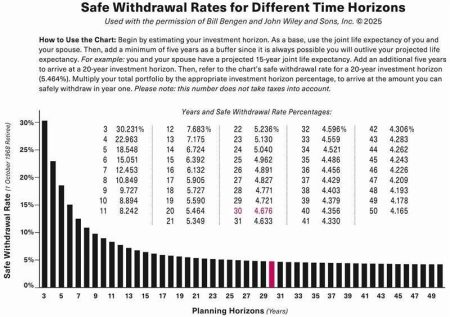If you’re contributing to a 401(k), chances are you’ve been default invested into a retirement target-date mutual fund—and you may not even know what that means.
These funds are often the default investment option in employer-sponsored retirement plans. They sound reassuring, with names like “Retirement 2045 Fund,” suggesting that someone has tailored a plan just for your future. But here’s the reality: that comfort may be misleading. These funds aren’t built for you. They’re built for everyone.
What Retirement Target-Date Funds Promise—And What They Don’t Deliver
Target-date mutual funds (TDFs) simplify investing by automatically adjusting your asset allocation over time. As you get closer to the fund’s “target” year, the mix of stocks and bonds shifts to become more conservative. The idea is to reduce risk as retirement nears.
But the problem is this: Target-date funds make assumptions that are unknown to anyone besides their portfolio manager. And chances are, the assumptions are not a perfect fit for you.
Do these funds ask how much you’ve already saved? Whether you’re married? If you’ll have a pension? Or what kind of legacy you want to leave? Aren’t those important factors that should be considered for you?
What is the expected rate of return of the Target date mutual fund? That is not expected to be a constant. Those in the industry know that there are a range of returns depending on volatility and the amount of risk being taken. You may get the negative range early and the higher end later. Also depending on when you start saving you may have missed the higher returns that would have compounded your dollars more.
The 401(k) Isn’t a Retirement Plan—It’s a Savings Vehicle
A 401(k) is a tax-advantaged savings account. The tax advantage has to do with deferral of the taxes on what you earn. Regarding your initial savings or contribution, you can decide if you want to have that taxed today, known as Roth, or not have it taxed and then pay taxes when you withdraw the money in the future. Outside of tax advantaged retirement accounts, your savings is subject to short and long-term capital gains.
It is not, by itself, a plan for retirement. Things like defined benefit pensions and Social Security have some actuarial assumptions. In the case of 401(k) and 403(b) plans, you decide whether to contribute to a traditional or Roth account. You decide how much to save. And you determine whether to accept the default investment or actively select your own. Will your assumptions and actions be sufficient?
For 2025, the IRS allows employees to contribute up to $23,000 to their 401(k) if they’re over 50 (or $19,500 if younger), source: IRS.gov. But just saving to the cap doesn’t guarantee success. That’s because the cap has nothing to do with what you actually need to retire comfortably. Neither does, saving to get the maximum match from your employer, if they offer a match.
The Missing Retirement Target-Date Mutual Fund Instructions
While you may have access to a 401(k) plan at work, it doesn’t come with instructions on Your employer may suggest contributing 3% of your income by defaulting your contribution to that percentage. Your company might offer a match. That’s a good start—but not a finish line. And if you’re defaulted into a TDF, you’re likely assuming it will get you to retirement. Unfortunately, it probably won’t.
Target-date funds don’t account for:
- How much income you’ll want in retirement
- Whether you’re married or single
- Social Security timing strategies
- Pension eligibility
- Existing savings and future contributions
- Whether you’re using traditional or Roth savings
- Your desire to do Roth conversions
- Your risk need vs. risk preference
- Longevity in your family
These are questions a thoughtful retirement income plan should answer. A target-date fund simply doesn’t ask.
Instead of picking a fund based on a future date, start with your desired outcome.
Ask yourself:
- When do I want to retire?
- How much annual income will I need to feel secure and fulfilled?
- What income sources will I have—Social Security, pension, rental income?
- What’s my expected lifespan?
- What will healthcare and long-term care cost?
- Will I support others—children, grandchildren, aging parents?
Then, work backward. Factor in what you’ve already saved, where it’s saved (pre-tax, Roth, brokerage), and how much you plan to continue contributing. Your strategy should account for sequence of returns risk, tax diversification, and your personal glidepath.
Real-World Comparison
Consider two savers:
Age Income Accumulated Savings Time to Retirement
35 $80,000 $0 30 years
35 $160,000 $150,000 30 years
Should they both be saving the same amount if they were say trying to replace 70% of their current income throughout their retirement, inflation-adjusted? Much less would the same retirement target mutual fund get them there?
Under the Hood: What You Don’t See in a Retirement TDF
Every TDF family—Fidelity, Vanguard, T. Rowe Price—uses a different “glidepath,” the formula that shifts the portfolio over time. Some use index funds. Others use actively managed strategies. Some de-risk more quickly; others stay aggressive into retirement.
That means two investors with the same retirement year could be taking different risk levels depending on their fund family. And unless you dig into the details, you’d never know.
A 2024 analysis from Morningstar found that the equity allocation of 2025 target-date funds ranged from as low as 25% to as high as 60% source: Morningstar. That’s a massive difference in risk for people on the brink of retirement.
Final Thoughts on Retirement TDFs
If you want to retire with peace of mind—and stay retired with confidence—you deserve more than a plug-and-play investment. Talk to a designated retirement professional such as a Certified Financial Planner™ (CFP®), Retirement Income Certified Professional® (RICP), or Chartered Retirement Planning Counselor® (CRPC®). They can help you turn your savings into a sustainable, tax-efficient, and personally meaningful retirement.
Retirement target-date mutual funds offer a helpful starting point. But they are no substitute for a personalized plan. They promise simplicity—but at the cost of precision.
:
Read the full article here









